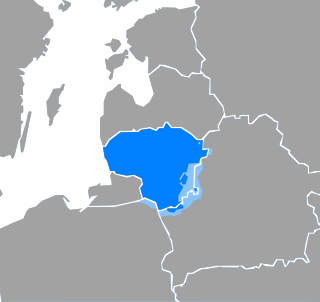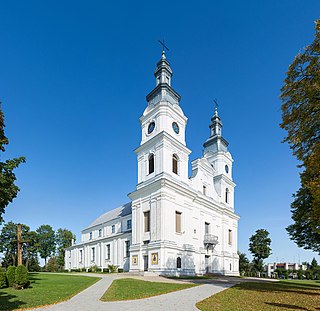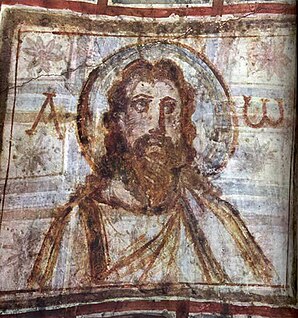
Klaipėda is a city in Lithuania on the Baltic Sea coast. It is the third largest city in Lithuania and the capital of Klaipėda County.
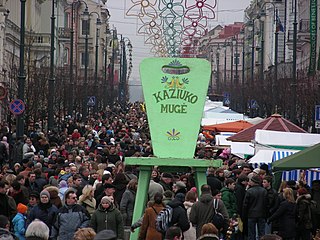
Kaziuko mugė or Saint Casimir's Fair is a large annual folk arts and crafts fair in Vilnius, Lithuania, dating to the beginning of the 17th century. The fair is traditionally held in city's markets and streets on the Sunday nearest to March 4, the anniversary of Saint Casimir's death. In Lithuanian, Kaziukas is a diminutive of Casimir. Today, Saint Casimir's fair also features music, dance, theater performances; it attracts tens of thousands of visitors and many craftsmen from across Lithuania as well as from neighbouring countries such as Latvia, Russia, and Poland. In recent years, the fair has expanded into other cities in Lithuania, Belarus, Poland.

The Great Jubilee in 2000 was a major event in the Roman Catholic Church, held from Christmas Eve 1999 to Epiphany 2001. Like other previous Jubilee years, it was a celebration of the mercy of God and forgiveness of sins. The major innovation in this Jubilee was the addition of many "particular Jubilees" for various groups of persons, and that it was simultaneously celebrated in Rome, Israel, and elsewhere in the world.

The Sanctuary of Our Lady of Lourdes or the Domain is an area of ground surrounding the Catholic shrine (Grotto) to Our Lady of Lourdes in the town of Lourdes, France. The Sanctuary is a destination for pilgrimage; sick pilgrims are reputed to be miraculously healed by Lourdes water. This ground is owned and administered by the Roman Catholic Church, and has several functions, including devotional activities, offices, and accommodation for sick pilgrims and their helpers. The Domain includes the Grotto itself, the nearby taps which dispense the Lourdes water, and the offices of the Lourdes Medical Bureau, as well as several churches and basilicas. It comprises an area of 51 hectares, and includes 22 separate places of worship. There are six official languages of the Sanctuary: French, English, Italian, Spanish, Dutch and German.
Litany, in Christian worship and some forms of Judaic worship, is a form of prayer used in services and processions, and consisting of a number of petitions. The word comes through Latin litania from Ancient Greek λιτανεία (litaneía), which in turn comes from λιτή (litê), meaning "supplication".

Kryžių kalnas, or the Hill of Crosses, is a site of pilgrimage about 12 km north of the city of Šiauliai, in northern Lithuania. The precise origin of the practice of leaving crosses on the hill is uncertain, but it is believed that the first crosses were placed on the former Jurgaičiai or Domantai hill fort after the 1831 Uprising. Over the generations, not only crosses and crucifixes, but statues of the Virgin Mary, carvings of Lithuanian patriots and thousands of tiny effigies and rosaries have been brought here by Catholic pilgrims. The exact number of crosses is unknown, but estimates put it at about 55,000 in 1990 and 100,000 in 2006.

Kalvarija is a city in southwestern Lithuania, located in the Marijampolė County, close to the border with Poland.
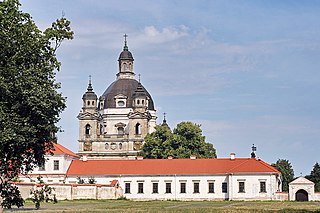
The Catholic Church in Lithuania is part of the worldwide Catholic Church, under the spiritual leadership of the Pope in Rome.

Lithuania attracts many tourists from neighbouring countries and all over the world. In 2017, 1,4 million foreign tourists arrived to Lithuania. Historical legacy of the Grand Duchy of Lithuania, pristine nature, seaside and SPA resorts are the main attraction points of Lithuania. Domestic tourism is also highly popular - in 2018 it grew by 12% percent. Lithuanians also prefer to spend their vacations in Lithuania - 70 percent.

The Roman Catholic Diocese of Telšiai is a suffragan Latin diocese in the ecclesiastical province of the Metropolitan of Kaunas, one of two in Lithuania.
Parbėg laivelis is an international folk festival in Klaipėda, Lithuania. The festival is held once every two years, in June or July. Its name Parbėg laivelis could be translated as Little ship is coming back.
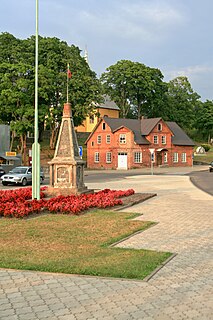
Žemaičių Naumiestis is a town in Klaipėda county, Šilutė district municipality in western Lithuania, between Klaipėda and Kaliningrad Oblast. The rivers Šustis, Šelmuo and Lendra flow through it.
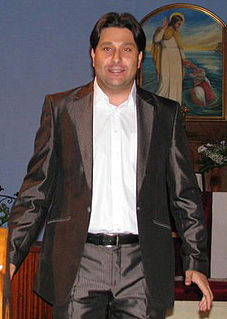
Mindaugas Rojus is a Lithuanian opera singer, a soloist of Klaipėda State Music Theatre, and a member of a stage duo Žemaitijos perlai.

Devilstone Open Air is a summer open air rock and metal music festival. It takes place annually since 2009 in the town of Anykščiai, in Lithuania. Devilstone Open Air has included performers playing black metal, death metal, power metal, thrash metal, sludge metal, doom metal, post rock, stoner rock, and progressive rock music genres. Music bands from Europe, North and South America, and Australia have performed in the festival. Devilstone Open Air is usually held in the mid-summer, around the third weekend of July.

St. George Orthodox Church is a prominent church that belongs to the Malankara Orthodox Syrian Church. This church is situated beside the Puthuppally-Changancherry road about a kilometre from the Puthuppally junction, on the eastern bank of the Kodoor river. The surrounding areas of church are panoramic and very beautiful. The old church was well preserved church with wall murals dating back to ancient times. These unique wall murals have been painted using vegetable dyes.

The Lithuania Song Festival is a massive traditional song and dance festival. Since regaining the Independence in 1990, the event has gained the status of the national celebration. The most recent event took place between 30 June and 6 July, 2018. The 2018 edition of the Song Celebration was dedicated to the Centenary of the Restoration of the independent state of Lithuania and took place in Kaunas and Vilnius. The main event has been hosted in Vingis Park in Vilnius.
Jonas Smalakys (1835–1901) was a Prussian Lithuanian landowner, soldier, and the first Prussian Lithuanian to be elected to the Reichstag.
The 2018 A Lyga was the 29th season of the A Lyga, the top-tier association football league of Lithuania. The season began on 25 February 2018 and ended on 11 November 2018.

